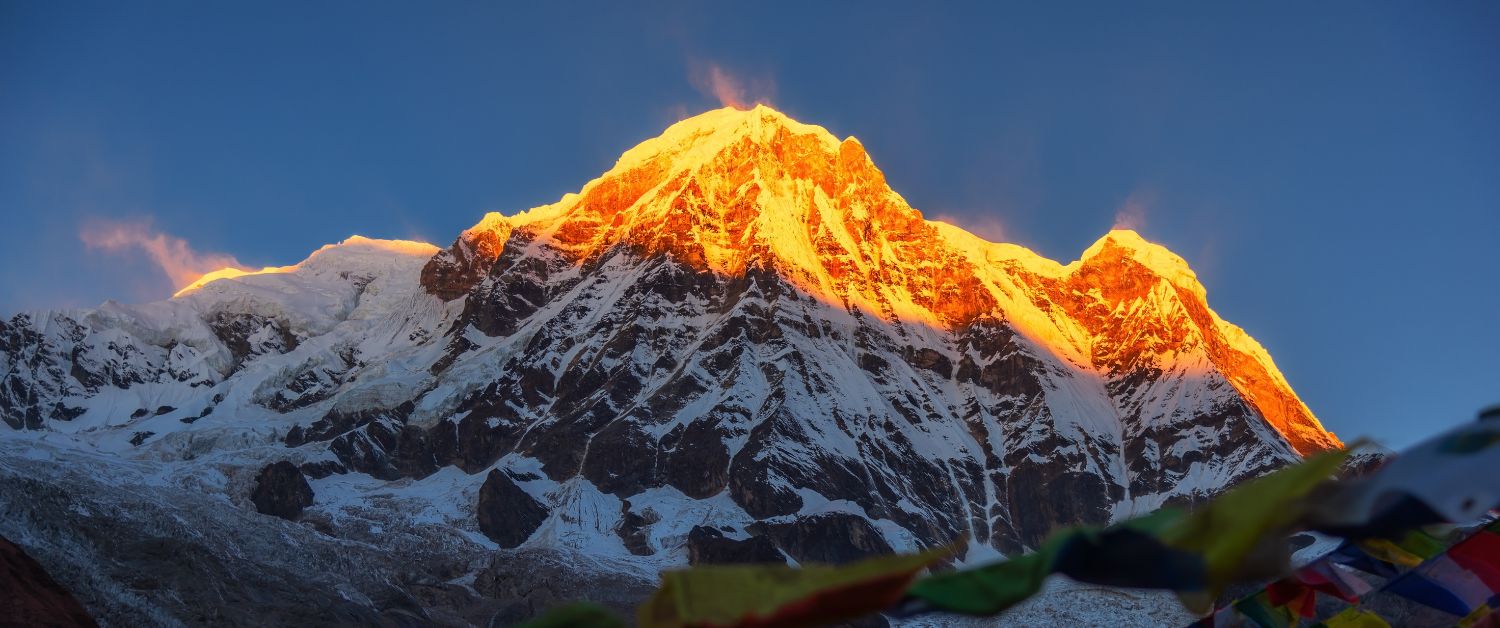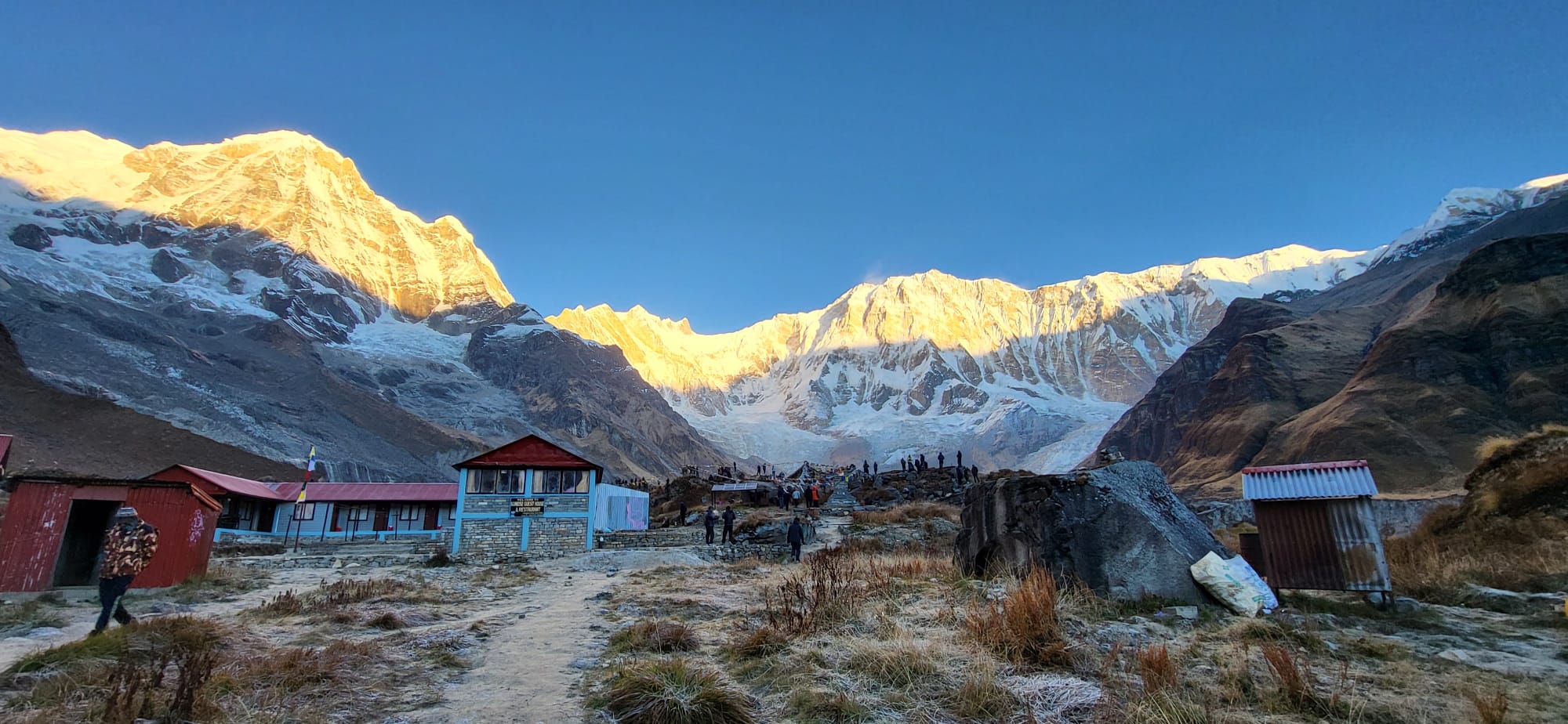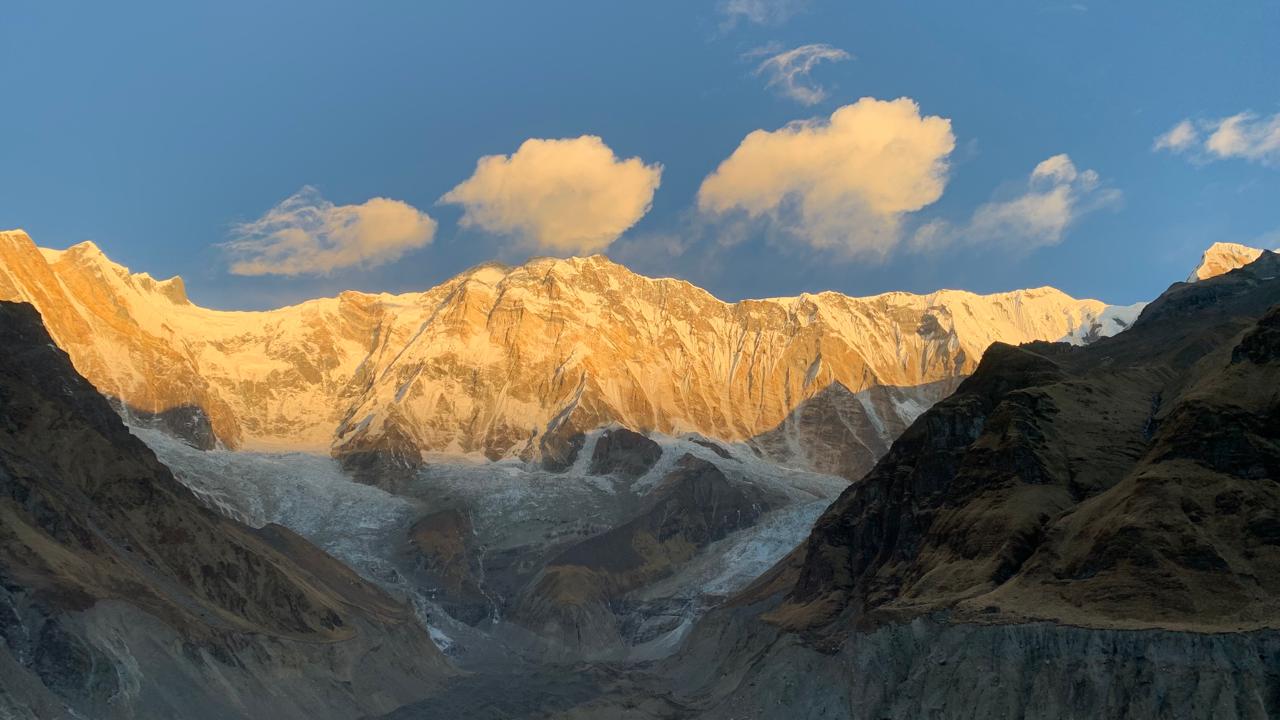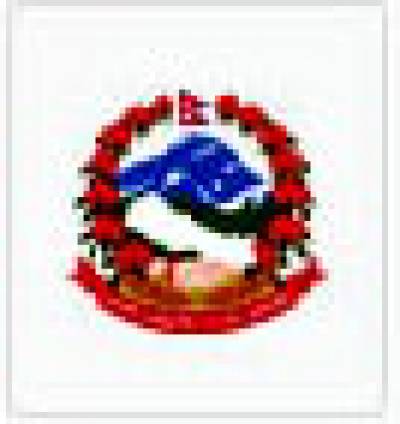9 DAYS ANNAPURNA BASE CAMP TREK
The 9-day Annapurna Base Camp Trek is an ideal choice for trekkers seeking to experience the stunning beauty of the Annapurna region without committing to an extended trek. This journey takes you through some of the most picturesque landscapes in Nepal, offering breathtaking views of the majestic mountains and a chance to immerse yourself in the rich cultural heritage of the area.
Your adventure begins in Kathmandu, Nepal’s bustling capital. After a brief rest and orientation, you’ll board a scenic flight to Pokhara, a charming lakeside city that acts as the gateway to the Annapurna region. From Pokhara, you’ll embark on a drive to Siwai, the starting point of your trek. The trek takes you towards Upper Sinuwa, as you walk through lush forests, terraced fields, and traditional villages, while enjoying spectacular views of the surrounding peaks. Along the way, you’ll experience the vibrant local culture and interact with the friendly locals.
After reaching Upper Sinuwa, you’ll continue your trek towards Deurali, where you’ll spend the night surrounded by stunning views of the Annapurna massif. The next day, you’ll reach the ultimate destination of your trek—Annapurna Base Camp (ABC). Standing at 4,130 meters, ABC offers some of the most panoramic and awe-inspiring views of towering peaks, including Annapurna I, Annapurna South, and Machapuchare (Fishtail). The serene atmosphere at ABC is a perfect reward for your trekking efforts.
After soaking in the beauty of ABC, you’ll retrace your steps back through Sinuwa, heading towards Jhinu Danda where you can unwind in the natural hot springs. Following a relaxing soak, you’ll continue to Nayapul and drive back to Pokhara. Finally, you’ll take a short flight back to Kathmandu, bringing your unforgettable Annapurna Base Camp trek to a close.
This 9-day Annapurna Base Camp Trek provides an excellent opportunity to experience the grandeur of the Himalayas in a condensed time frame, making it an ideal adventure for those with limited time in Nepal.
ITINERARY
Day 1 : Arrival in Kathmandu and Transfer to Hotel.
Upon arrival at Tribhuvan International Airport in Kathmandu, you will be greeted by your guide and transferred to your hotel. After settling in, you may have some free time to relax or explore the vibrant capital of Nepal. In the evening, there will be a pre-trek briefing where you'll receive important information about your upcoming adventure.
Day 2 : Fly to Pokhara, Drive to Nayapul (1,050m), and Trek to Ghandruk (1,940m) Duration: 5-6 hours.
After breakfast, you will take a scenic flight from Kathmandu to Pokhara, offering stunning views of the Himalayan ranges. Upon arrival, you will drive to Nayapul (1,050m), the starting point of your trek. From here, the trail leads through beautiful terraced fields and charming villages to Ghandruk (1,940m), a scenic Gurung village. The trek takes about 5-6 hours and offers stunning views of peaks such as Machapuchhre (Fishtail) and Annapurna South.
Day 3 : Trek to Chhomrong (2,170m) Duration: 5-6 hours.
Today, you will trek from Ghandruk to Chhomrong, located at an altitude of 2,170 meters. The journey involves a 5-6 hour trek through forests, terraced fields, and traditional villages. As you ascend, you will be treated to fantastic views of the Annapurna range. Chhomrong is a beautiful village and a key stop along the trail, with spectacular views of Annapurna South and Machapuchhre.
Day 4 : Trek to Himalaya (2,920m) Duration: 5-6 hours.
Today’s trek takes you from Chhomrong to Himalaya, situated at 2,920 meters. The route gradually ascends through rhododendron forests and along the banks of the Chhomrong Khola. As you climb higher, you will witness magnificent views of the Annapurna Massif and the surrounding peaks. This portion of the trek is approximately 5-6 hours, and you'll spend the night in Himalaya, a small settlement with a peaceful atmosphere.
Day 5 : Trek to Annapurna Base Camp (4,130m) via Machhapuchhre Base Camp (3,720m) Duration: 5-6 hours.
The day begins with a challenging yet rewarding trek to Annapurna Base Camp (ABC). Starting from Himalaya, you’ll trek through alpine meadows, crossing small streams and passing Machhapuchhre Base Camp (MBC) at 3,720 meters. The trek offers fantastic views of Machapuchhre (Fishtail) and Annapurna I. After a 5-6 hour trek, you’ll finally reach Annapurna Base Camp at 4,130 meters, where you can relax and take in the spectacular panoramic views of Annapurna I, Annapurna South, Himalchuli, and Machapuchhre.
Day 6 : Trek to Bamboo (2,350m) Duration: 5-6 hours.
After an unforgettable time at Annapurna Base Camp, you’ll begin your descent back towards Bamboo (2,350m). The descent takes approximately 5-6 hours, following the same route but in reverse. The trail passes through Himalaya and Deurali before reaching Bamboo, a beautiful village where you can relax and enjoy the views of the surrounding mountains.
Day 7 : Trek to Jhinu Danda (1,780m) Duration: 5-6 hours.
Today, you will trek from Bamboo to Jhinu Danda (1,780m). The trek takes about 5-6 hours and descends through lush forests, passing small settlements and terraced fields. Once you arrive at Jhinu Danda, you can relax in the natural hot springs, which are a great way to soothe your muscles after several days of trekking.
Day 8 : Trek to Nayapul and Drive to Pokhara (850m), Fly to Kathmandu Duration: 6-7 hours.
On this day, you will trek from Jhinu Danda to Nayapul, which takes about 6-7 hours. The trail passes through terraced fields and scenic villages, offering great views of the surrounding landscape. Once at Nayapul, you will drive back to Pokhara and, after a brief rest, catch a scenic flight back to Kathmandu. After your arrival, you will be transferred to your hotel for the night.
Day 9 : Transfer to the International Airport for Final Departure.
On your final day in Nepal, depending on your flight time, you may have some free time to shop or explore more of Kathmandu. When it’s time for your departure, you will be transferred to Tribhuvan International Airport for your flight back home, bringing an end to your incredible journey through the Annapurna region.
SERVICES
Cost Included in Your Package
- International & Domestic Airport Transfers: Convenient pick-up and drop-off services by car for both international and domestic airports.
- Meals During the Trek: Enjoy three daily meals—breakfast, lunch, and dinner—during your trek in the mountains.
- Accommodation in Kathmandu: Two nights of standard accommodation at a 3-star hotel in Kathmandu, on a twin-sharing basis, including breakfast.
- Experienced Trekking Guide: An English-speaking, government-registered trekking guide with extensive knowledge and experience.
- Sherpa Porters: Strong and supportive Sherpa porters equipped with proper safety and walking gear. Includes their salary, food, accommodation, and insurance (one porter per two trekkers).
- Flights: Return flights between Pokhara and Kathmandu.
- Local Transportation: Transportation by car or jeep from Pokhara to Nayapul back to Pokhara.
- Porter and Guide Expenses: All food, accommodation, insurance, and transportation costs for the porter and guide.
- Permits: Annapurna Conservation Area Permit and TIMS (Trekking Information Management System) card.
- Gear Rental: Use of sleeping bag, down jacket, duffel bag, and walking poles (if needed), to be returned after the trip.
- Trekking Lodge (Tea House) Stays: Comfortable lodging throughout your trek. (Accommodation Notice ) "During peak trekking seasons (mid-March to end of May & mid-September to end of November), teahouses in regions such as the Himalayas, Deurali, MBC, Annapurna Base Camp, and Bamboo typically offer shared rooms with 4–5 beds. Private rooms are generally not available during this time due to high demand. Please be prepared for shared lodging, as this is the standard accommodation setup in these high-traffic areas."
- Assistant Guide: An additional assistant guide for groups larger than 8 people.
- Fresh Fruits: Seasonal fresh fruits are provided daily.
- Completion Certificate: An appreciation certificate awarded after a successful trek.
- Sherpa Teams T-shirt: A complimentary Sherpa Teams company T-shirt.
- Emergency Assistance: Support for arranging emergency rescue operations in complex health conditions (funded by travel insurance).
- Oximeter to check your pulse and oxygen saturation and heart rate twice daily (Very useful to check Altitude Mountain Sickness(AMS) symptoms) Which will ensure you trek is in the safest hands possible for all levels of trekker.
Costs Excluded
- Meals in Kathmandu & Pokhara: Lunch and dinner in Kathmandu and Pokhara.
- Nepal Entry Visa Fee: Visa on arrival at Tribhuvan International Airport costs $30 USD for 15 days, $50 USD for 30 days, and $125 USD for 90 days.
- Travel and Medical Insurance: Personal travel and medical insurance.
- International Airfare: Flights to and from Nepal.
- Personal Expenses: Any personal expenditures, including shopping and souvenirs.
- Beverages and Extra Food: Costs for alcoholic and non-alcoholic drinks, soups, tea, coffee, hot chocolate, cocoa, mineral water, and any additional food or drinks purchased along the trek or in tea houses.
- Desserts and Sweets: All desserts and sweet items such as chocolate, cake, pie, and pudding.
- Hot Showers and Battery Charging: Charges for hot showers and battery charging at tea houses.
- Tips: Tips for your guide, porter, and driver.
EQUIPMENTS
The following information will give you some idea about what you need to bring for the trek. It is important you do not forget the essential items, as this will determine your comfort and safety on the trek. Equally important is that you do not burden yourself with unnecessary equipment on the trek.
General
- All season sleeping bag and down Jacket (we can provide if you need it, but has to be returned after the trek)
- Duffle bag ( Sherpa Expedition & Trekking provide duffle bag during the trek but has to be returned after the trek)
- A wind and waterproof thin layered jacket (a must-have for morning and evenings above 3,000m)
- Daypack
Upper Body- Head / Ears / Eyewear
- A pair of half gloves
- A warmer hat that covers the ears
- Sunglasses
- Neckwarmer
- Sunscreen (35 to 60 SPF)
- Headlamp and an extra set of batteries
Hands
- A pair of half gloves for walking poles(if you prefer)
- Warmer shell gloves and liner
Upper Body
- long sleeve t-shirts
- Thermal tops
- wool jacket or pullover
- Sports bras for women and girls
- Water and windproof shell jacket
Lower Body
- Thermal underwear (especially trousers)
- windproof and waterproof trousers
- warmer trousers
- Comfortable trekking pants
- Extra casual sport pants
Footwear
- A pair of good waterproof trekking boots
- Pair of sandals
- 4-5 pairs of woolen socks
- Sock liners
- Light shoes and sneakers
- First Aid Kits and Medicines
- Assorted adhesive bandages (fabric preferred)
- Blister treatment cream or similar
- Insect / anti-itch ointment
- Ibuprofen or other pain-relief medication
- Diamox (125mg to 250mg tablets for altitude sickness)
- Warps, splints, and wound coverings butterfly bandage
- Water purifying pills
(Note our company guide will carry the medicines and first aid kits during the trek. However, we recommend you bring your personal first-aid kit as well)
Miscellaneous - but must useful on the trek
- 4 passport size photos with original passport
- Water bottle & filter
- Flight details (please make a copy and leave one pic at our office in KTM because in case you want to change your flight date)
- Bathroom kit (conform, should be included toilet paper, plastic bags, hand wipes, towel, and soap, etc.)
Extra things
- Comfortable trekking poles
- Quality energy dry foods (up to you)
- Power bank and music players
- Camera (memory card, chargers, and extra batteries)
GOOD TO KNOW
🗓️ Best Time to Trek
The best times to trek to Annapurna Base Camp are during the spring (March to May) and autumn (September to November). During these months, the weather is stable, offering clear skies and magnificent views of the surrounding peaks. Temperatures are moderate, making it easier to hike, and you’ll avoid the extreme weather conditions found in the winter or monsoon months.
🏔️ Altitude Considerations
Annapurna Base Camp sits at an altitude of 4,130 meters, so trekkers should be mindful of altitude sickness. While the trek doesn’t reach extreme altitudes, it’s important to acclimatize properly. The itinerary is designed to gradually increase in altitude, allowing you to adjust at a safe pace. Staying hydrated and taking rest days when needed will help minimize altitude-related risks.
💪 Fitness Level
This trek is of moderate difficulty and is suitable for trekkers with a basic level of fitness. You don’t need to be an expert hiker, but you should be able to walk for 5-7 hours each day at a steady pace. Training in advance, such as hiking or walking regularly, will help prepare your body for the challenges of the trek, especially the steep sections and variable terrain.
🎒 Packing Essentials
Packing smart is key for a successful trek. Essential items include sturdy trekking boots, a good quality sleeping bag, warm layers (especially for evenings and mornings), a waterproof jacket, sunscreen, a water bottle, and a camera to capture the stunning views. You’ll also need a first aid kit, trekking poles, and extra socks. You can also rent trekking gear in Kathmandu or Pokhara if needed.
📝 Permits
To trek in the Annapurna region, you’ll need two important permits: the Annapurna Conservation Area Permit (ACAP) and the TIMS (Trekkers’ Information Management System) card. These can be obtained easily in Kathmandu before your trek. The permits are essential for environmental conservation and help manage tourism in the region.
🏡 Trekking Accommodation
Accommodation along the Annapurna Base Camp route typically consists of local teahouses. These teahouses provide basic facilities, including a bed, meals, and a warm drink. While teahouses offer a basic but comfortable place to rest, the rooms are typically shared, and hot water may be limited. Some teahouses offer Wi-Fi and charging options for a small fee.
🙏 Cultural Etiquette
Nepal has a rich and diverse culture, and it’s important to be respectful when interacting with locals. When visiting religious sites or homes, always ask for permission before taking photos. It’s customary to greet people with a smile and a traditional "Namaste" (a gesture of respect with hands pressed together). Show respect for elders and local customs, and avoid touching religious statues or offerings.
🌦️ Weather Conditions
Weather in the Annapurna region can change quickly, so be prepared for fluctuating temperatures. At lower altitudes, temperatures are warm during the day, but it can get very cold at higher altitudes, especially in the mornings and evenings. It’s essential to bring layered clothing to stay warm, along with a waterproof jacket to protect yourself from sudden rain or snow.
🚶♂️ Safety
Safety should always be a priority when trekking in the Himalayas. While the trail to Annapurna Base Camp is well-marked and accessible, it’s recommended to trek with a guide who can assist with navigation, monitor your health, and provide emergency assistance if necessary. Your guide will also ensure you follow proper acclimatization protocols to avoid altitude sickness.
🏞️ Trekking Gear
If you don’t have the necessary trekking gear, you can easily rent or purchase equipment in Kathmandu or Pokhara. Many shops offer affordable rental options for trekking poles, sleeping bags, jackets, and other essentials. Renting gear ensures you don’t have to carry unnecessary weight, and you’ll be able to find gear that fits the specific conditions of the trek.
MAP
PHOTOS/Videos
Departures
Select a departure month
Fill out the form below and a Travel Expert will reach out to create your perfect tour.
FAQS
What is the best time to do the 9-day Annapurna Base Camp Trek?
The best times to trek are during spring (March to May) and autumn (September to November). These seasons offer clear skies, mild temperatures, and excellent visibility of the mountains.
Do I need previous trekking experience for this trek?
No, previous trekking experience is not required. However, a basic level of fitness is recommended, as the trek involves walking for several hours each day at increasing altitudes.
How challenging is the 9-day Annapurna Base Camp Trek?
The trek is considered moderate in difficulty. It involves steady ascents, some steep sections, and long walking days, but there is no technical climbing, making it suitable for trekkers with basic hiking experience.
What is the highest altitude of the trek?
The highest point of the trek is Annapurna Base Camp (ABC) at 4,130 meters (13,550 feet). Proper acclimatization is important to avoid altitude sickness.
Can I trek without a guide?
While it is possible to trek independently, it is highly recommended to hire a guide. A guide ensures safety, helps with navigation, and provides insight into local culture, as well as helping with permits and acclimatization.
What permits do I need for this trek?
You will need two permits:
- Annapurna Conservation Area Permit (ACAP)
- Trekkers’ Information Management System (TIMS) card
These permits can be obtained in Kathmandu or Pokhara before starting the trek.
What type of accommodation can I expect?
Accommodation is mainly in teahouses or lodges, which offer basic facilities. Rooms typically have shared bathrooms, and meals are served at the teahouses, with a variety of local and international options.
How many hours do I trek each day?
On average, you will trek for 5-7 hours each day, depending on the distance and elevation gain. Some days may be shorter, while others could be longer, depending on the terrain.
What should I pack for the 9-day trek?
Essential items include trekking boots, warm clothing, rain gear, sunscreen, water bottles, headlamp, first aid kit, and a sleeping bag. You can buy or rent gear in Kathmandu or Pokhara.
Is it safe to trek in the Annapurna region?
Yes, the Annapurna region is a popular and well-maintained trekking area. As long as you follow your guide's advice, take regular rest breaks, stay hydrated, and acclimatize properly, the trek is safe. However, altitude sickness remains a risk, so it’s important to monitor symptoms closely.
Latest Traveller’s Reviews
Travel experiences of our clients who recently returned from their trips.
100%
Based On 4 Reviews
Grace Anderson
United States
Mountains, Magic & Mindfulness
What started as a simple escape from city life turned into a soul-refreshing experience in the Himalayas. The way the trail shifted from terraced farms to alpine landscapes left me speechless more than once. The group I joined felt like a temporary family, sharing laughter, ginger tea, and stories under the stars. Everything was taken care of with such ease that I could simply walk, breathe, and soak in the surroundings. This wasn’t just a trek—it was a reconnection with nature and myself.
Tomasz Nowak
Poland
Immersed in Majesty
I’ve been to many mountain ranges, but nothing compares to the Annapurna region. The ABC trek is a masterpiece of natural wonder. What struck me most was the constant transformation in scenery—from rice paddies and rhododendron forests to snowfields and glaciers. Each day felt like trekking into a new world. The villages along the way offered authentic hospitality, and the food, though simple, was hearty and nourishing. The elevation gain was gradual enough to acclimatize, and I appreciated the thoughtful route planning. What made it unique was the emotional impact of standing at Annapurna Base Camp. The towering presence of Annapurna I, flanked by Machapuchare and other giants, creates a cathedral of ice that takes your breath away—literally and figuratively. I didn’t expect to feel so emotional, but I was overwhelmed with awe. There’s a sacred energy there that words can’t fully describe. Watching the sunrise illuminate the peaks in pink and gold will stay with me forever. This trek is not just about physical endurance, but about surrendering to nature's grandeur. For those who crave something deep and unforgettable, ABC is your calling.
Aiko Tanaka
Japan
Peace in Every Step
The Annapurna Base Camp trek is not just a physical adventure—it’s an emotional and spiritual experience. As someone who seeks calm and reflection, this journey gave me more than I expected. From the peaceful hum of the forests to the quiet stillness at sunrise, each moment brought serenity. I found beauty not only in the towering peaks but in the small details: children waving from fields, the sound of prayer wheels turning, and the simple joy of drinking masala tea after a long day. The trail encouraged presence. Unlike a fast-paced vacation, this trek asks you to slow down, listen, and absorb. Even the physical effort became meditative—step after step, breath after breath. I found myself deeply connected with nature and surprisingly connected with fellow trekkers, despite language differences. At the base camp, as I stood in a natural amphitheater of white giants, time paused. There was no rush—only wonder. I left behind daily distractions and returned feeling lighter in body and spirit. For those looking for more than just adventure—for peace, for clarity—this trek is a gift.
People Considering This Package Right Now Check availability
























